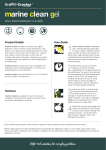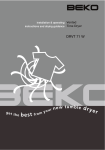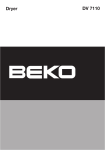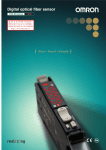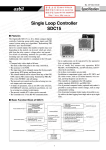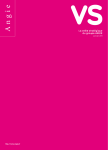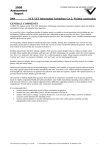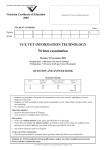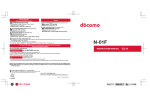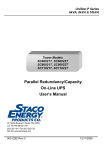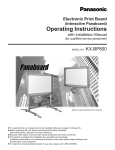Download for Windows and Macintosh User Guide
Transcript
User Guide for Windows® and Macintosh® Trademarks SuperGOO is a trademark of ScanSoft, Inc. “Macintosh” is a registered trademark of Apple Computer, Incorporated. “Windows” and “PowerPoint” are registered trademarks of Microsoft Corporation. “Pentium” is a registered trademark and “i486” is a trademark of Intel Corporation. ImageStream is a trademark and ImageStream Graphics Filters is a registered trademark of INSO Corporation. All other product names mentioned in the manual and other documentation are used for identification purposes only and may be trademarks or registered trademarks of their respective companies. Registered and unregistered trademarks used herein are the exclusive property of their respective owners. ScanSoft, Inc. makes no claim to any such marks, nor willingly or knowingly misused or misapplied such marks. Copyright This manual, as well as the software described in it is furnished under license and may only be used or copied in accordance with the terms of such license. Program ©1998–1999 ScanSoft, Inc., including the look and feel of the product. SuperGOO User Guide ©1998–1999 ScanSoft, Inc. No part of this guide may be reproduced in any form or by any means without the prior written permission of ScanSoft, Inc. Notice Before using this software or reading this user guide, make sure you have read, understood and agreed to the license displayed on screen during the software installation process. © 1998-1999 ScanSoft, Inc. 9 Centennial Drive Peabody, MA 01960 SuperGOO User Guide Table of Contents Welcome to SuperGOO . . . . . . . . . . . . . . . . 5 What’s New? . . . . . . . . . . . . . . . . . . . . . 5 Installation . . . . . . . . . . . . . . . . . . . . . . . . . . . 5 Windows Installation . . . . . . . . . . . . . . 5 Macintosh Installation . . . . . . . . . . . . . 6 Installation Tips . . . . . . . . . . . . . . . . . . 6 About This User Guide . . . . . . . . . . . . . . . . 7 Conventions . . . . . . . . . . . . . . . . . . . . . 7 Technical Support . . . . . . . . . . . . . . . . . . . . . 8 Chapter 1 Getting to Know Kai’s SuperGOO . . . . . . . . . . . . . . . . 11 What is SuperGOO? . . . . . . . . . . . . . . . . . . 11 What can I do with Kai’s SuperGOO? . . . . . . . . . . . . . . . . 11 Exploring the Kai’s SuperGOO Workspace . . . . . . . . . . . . . . . . 11 The FUSION Room . . . . . . . . . . . . . . 12 The GOO Room . . . . . . . . . . . . . . . . . 12 The Option Buttons . . . . . . . . . . . . . . 13 The Basics of Working with Kai’s SuperGOO . . . . . . . . . . . . . . . . . 13 Working with Rooms . . . . . . . . . . . . . 13 Working with Files . . . . . . . . . . . . . . . 13 Saving Pictures . . . . . . . . . . . . . . . . . . . . . . 14 Printing Pictures . . . . . . . . . . . . . . . . . . . . . 15 Chapter 2 Just GOO It!: A Tutorial . . . . . . . . 17 Welcome . . . . . . . . . . . . . . . . . . . . . . . . . . . Getting Started . . . . . . . . . . . . . . . . . . . . . . Lesson 1: Moving Between Rooms . . Making Faces . . . . . . . . . . . . . . . . . . . . . . . Lesson 1: Making a Random Face . . Lesson 2: Adding Features . . . . . . . . . Lesson 3: Editing Features . . . . . . . . . Lesson 4: Cloning Features . . . . . . . . GOO It . . . . . . . . . . . . . . . . . . . . . . . . . . . . . Lesson 1: GOOing Using Brushes . . Lesson 2: GOOing Using Effects . . . . Making GOOvies . . . . . . . . . . . . . . . . . . . . Moving On . . . . . . . . . . . . . . . . . . . . . . . . . Chapter 3 The GOO Room ................. How the GOO Room Works . . . . . . . . . . . Working in the GOO Room . . . . . . . . . . . Opening or Importing Images . . . . . Viewing an Image . . . . . . . . . . . . . . . Setting Up Brushes . . . . . . . . . . . . . . . Mirroring a Brush Effect . . . . . . . . . . Using the GOO Brush Palette . . . . . . . . . . Using the GOO Effects Palette . . . . . . . . . Adding Text . . . . . . . . . . . . . . . . . . . . . . . . 17 17 17 18 18 19 20 21 23 24 27 28 29 31 31 32 32 33 33 34 34 36 38 Making GOOvies . . . . . . . . . . . . . . . . . . . . Working with Keyframes . . . . . . . . . Using the Control Slider . . . . . . . . . . Playing Your Movies . . . . . . . . . . . . . Saving Animations . . . . . . . . . . . . . . . Chapter 4 The FUSION Room ............. How the Fusion Room Works . . . . . . . . . Working in the FUSION Room . . . . . . . . Opening and Importing Pictures . . . Using the Face Palette . . . . . . . . . . . . . . . . Changing Features . . . . . . . . . . . . . . . Hiding/Showing Features . . . . . . . . . Using the Edit Palette . . . . . . . . . . . . . . . . . Randomizing Features . . . . . . . . . . . . . . . . Combining Features . . . . . . . . . . . . . . . . . . Saving Faces . . . . . . . . . . . . . . . . . . . . . . . . Using your Own Photos in the Fusion Room . . . . . . . . . . . . . . . . . . Contents 39 39 40 40 41 43 43 44 44 45 45 46 46 48 48 49 50 iii iv Kai’s SuperGOO CWelcome to SuperGOO Kai’s SuperGOO is the evolution of the fabulously successful Kai’s Power GOO, the latest release of Liquid Image™ “Funware” from ScanSoft, Inc. All the fun you had GOOing faces and pictures has been greatly enhanced, and the FUSION Room now has its own library of facial components you can pick from. What’s New? If you’re a user of GOO this section will give you a head start on locating, learning and taking advantage of SuperGOO’s new features. The GOO Room The GOO Room still lets you play with images as if they were made out of liquid paint, but several improvements have been made to the basic GOO functions: • Zooming and Panning • Customizable Brush Sizes and Functions • Support for non-square images (images at any aspect ratio) • Support for Alpha Channels The FUSION Room Before, you could use the FUSION Room to merge two pictures together to make a new goofy image. Now, the FUSION Room lets you create faces using a host of facial features. You can add a nose, mouth, eyes and hair to a blank face to create your own original face. These features are included in a library that comes with the application. CInstallation This section provides instructions for installing the Windows and Macintosh versions of your SuperGOO software. Follow the instructions appropriate for your system Windows Installation Minimum System Requirements SuperGOO runs on any PC compatible computer with the following minimum configuration: • Pentium Processor • Windows 95 (or higher) • Windows NT 4.0 (or higher) • 16 MB Free RAM • 25 MB HD Space for Install • 40 MB Free HD Space (after Install) 5 • CD-ROM Drive • 16 MB RAM allocated to application • 16-bit video • 25 MB HD Space for Install • 14" Monitor • 40 MB Free HD Space (after Install) • CD-ROM Drive • 16-bit video • 14" Monitor Installation BTo install your SuperGOO software: 1. Insert the SuperGoo CD-ROM disc into your CD-ROM drive. 2. If you are using Windows NT 4.0, select File menu> Run. If you are using Windows 95, select Start menu> Run. Installation BTo install your SuperGOO software: 3. Type the letter corresponding to your CD-ROM drive, followed by “:\setup (for example, type “d:\setup” if using the D drive). Click the OK button, then follow the prompts. 4. If in the main install window, click “Install.” Please be certain that you have at least 25 MB of free space on your hard disk before you install. Macintosh Installation Minimum System Requirements SuperGOO runs on any Macintosh computer with at least the following configuration: • Power Macintosh • MacOS 7.6.1 (or higher) 6 Kai’s SuperGOO User Guide 1. Insert the SuperGoo CD-ROM disc into your CD-ROM drive. 2. Double-click on the SuperGoo Install icon to begin installation. Installation Tips Windows 95/NT 4.0: Please be sure that: • Your operation system is Win95/NT4.0. SuperGoo will not run on Win 3.x or NT 3.x.x. • Your display is set to a minimum of 16-bit colors (65,000 colors). We recommend 24-bit (true color). • Your are using a Pentium processor or “Pentium class” processor. SuperGoo will NOT run on a 486. • There are no open applications (other than Win95/NT4.0, of course). • There are NO applications running in the background. This includes anti-virus software, crash monitors or system diagnostic software. Power Macintosh: Please be sure that: • Your operating system is 7.6.1 or higher. • Your display is set to a minimum of 16-bit colors (65,000 colors). We recommend 24-bit (true color). • You are not running Virtual Memory or any RAM enhancing program such as RAM Doubler. • Please be certain that you have at least 25 MB of free space on your hard disk before you install. • You might receive an error message while attempting to launch SuperGoo which states “The application SuperGoo could not be opened because axiom could not be found.” This means that the Macintosh does not have enough memory left after launching SuperGoo to load the necessary “axiom” extension. CAbout This User Guide This user guide provides all the information you need to get the most out of Kai’s SuperGOO. It will help you learn the application and serve as a reference as you attempt more sophisticated procedures. This user guide assumes you are already familiar with basic Windows and Macintosh concepts—menus, dialogs, and mouse operations, such as clicking and dragging. If you need more information on these subjects, or on the Macintosh Finder or the Windows Desktop, please refer to the Macintosh User’s Manual or the Microsoft Windows User’s Guide, respectively. Conventions This user guide is for both Windows and Macintosh users. By convention, Macintosh commands precede Windows commands in the text. For example, Command/Ctrl+I is equivalent to the Macintosh Command-I and the Windows Ctrl+I. For simplicity, the term folder refers to directories as well as folders. The Kai’s SuperGOO interface for both platforms is identical, unless otherwise specified. 7 CTechnical Support You will find the answers to most of your questions within the pages of this user guide. If you need further assistance, contact ScanSoft Customer Support on the World Wide Web at: www.scansoft.com Note: ScanSoft, Inc. reserves the right to change its support policies at any time. 8 Kai’s SuperGOO User Guide 9 10 Kai’s SuperGOO User Guide Getting to Know Kai’s SuperGOO CWhat is SuperGOO? Kai’s SuperGOO is the latest addition to the ScanSoft line of creative entertainment tools. Like its predecessor, Kai’s Power GOO, SuperGOO is a fun image-distortion tool. Using SuperGOO’s tools and effects, you can stretch, stir, bulge, or twirl pictures to create “funhouse mirror” distortion effects. Using the libraries that come with SuperGOO you can create your own realistic faces. Once distorted, an image can be printed or saved for use in photo-editing or compositing software or in a desktop publishing application. Multiple distortion effects can be combined to create animated movies (in QuickTime or AVI format) for use in multimedia presentations or output directly to video. What can I do with Kai’s SuperGOO? Animations can be used in multimedia authoring applications for inclusion in both on-screen and video-based presentations. Both images and animations can be incorporated into Web pages. CExploring the Kai’s SuperGOO Workspace Unlike most applications that use a myriad of palettes and toolbars to display their features, SuperGOO is divided into rooms. There are two rooms in SuperGOO: • The FUSION Room • The GOO Room These rooms contain all the features and functions you’ll need to fully express your creativity. The most obvious use for SuperGOO is to take images of family, friends and co-workers and use the SuperGOO distortion tools to create funny parodies of people for your own amusement. You can then save those images as parts of movies or as a still images. Images can be imported into image-editing applications for additional modifications or inclusion in advertising or fine art pieces. Getting to Know Kai’s SuperGOO 11 The FUSION Room The GOO Room The FUSION Room works like a police sketch artist’s tool. It lets you combine different facial components to create your own unique faces. Using the huge number of noses, eyes, mouths, heads and hair stored in the Kai’s SuperGOO library, you can create almost any face. You can also incorporate features from your own photographs. The GOO Room is where you distort images to create your own custom pictures. The images you use in this room can be imported from a variety of sources, or opened from the GOO library. Use the GOO Room to distort imported images. Use the FUSION Room to mix and match facial features to create your own faces. Once you’ve created a face, you can take it into the GOO Room and distort it just like you would any other image. Once open, you can use the GOO tools to distort, bulge, smear or twirl portions of the image, or use the GOO effects to twirl, rotate, stretch or squeeze the entire image. You can also save your picture at various stages and then play the images together as a movie, or GOOvie. 12 Kai’s SuperGOO User Guide The Option Buttons The three buttons that appear at the top of each room let you move between rooms and access import and export functions. BTo move between rooms: ✤ The Option buttons. In the GOO Room click the FUSION button at the top of the screen to move to the FUSION Room. In the FUSION Room, click the GOO button to move to the GOO Room. CThe Basics of Working with Kai’s SuperGOO Kai’s SuperGOO is an incredibly easy-to-use program. Most of Kai’s SuperGOO’s features are applied by a simple click and drag. The best way to get the most out of Kai’s SuperGOO is to just click a tool and try it. Working with Files Kai’s SuperGOO lets you import your own pictures of friends and family to distort or combine to create wacky pictures. You can open a file in BMP, PICT, Photoshop, TIFF, JPEG, GIF, or FlashPix. BTo open a picture: Before you start exploring, there are a few basic procedures you should know. These procedures apply to the entire application. 1. Click the In button at the top of the screen and choose Open from the popup menu. The Open dialog appears. Working with Rooms 2. Locate the picture file you want to use and click Open. The picture appears on the Image Canvas. You can move between rooms using the Option buttons at the top of the room. When you move from the FUSION Room to the GOO room, the picture on the Image Canvas moves with you. This way you can GOO a face you created in the FUSION Room. Importing Files using Plug-ins Kai’s SuperGOO can import images in a number of standard image formats. You can extend Kai’s SuperGOO’s import capabilities using third-party plug-ins. A plug-in is a component that connects with an application and extends its capabilities. In order to use a plug-in from an outside developer you have to place it in a folder that SuperGOO can access. Getting to Know Kai’s SuperGOO 13 BTo install plug-ins: ✤ In Finder or the Windows desktop, drag the plug-in application’s icon in to the SuperGOO: plugins folder. BTo import a picture using plug-ins: 1. Click the In button at the top of the screen and choose Import Via Plug-Ins > Set Destination for Acquires and Imports from the menu. The Set Destination dialog appears. 2. Select a folder on your system where you want imported images stored. 3. Click the In button again and choose Import Via Plug-Ins > Select Plug-ins Folder from the menu. The Select Folder dialog appears. 4. Locate the folder where you’ve stored your import plug-ins. Scanning Pictures You can scan images directly into Kai’s SuperGOO using a program interface called TWAIN. This interface lets Kai’s SuperGOO interact directly with your scanner. BTo scan a picture into Kai’s SuperGOO: 1. Click the In button and choose Import via TWAIN > Set Destination for Acquires and Imports from the menu. 2. Select a folder where you want to store scanned images. 3. Click the In button again and choose Import via TWAIN > Select TWAIN Source. The Select Source dialog appears. 4. Select your scanner from the list and click OK. 5. Click the In button again and choose Import via TWAIN > TWAIN Acquire. The TWAIN dialog appears. 6. Use the dialog controls to setup and start a scan of your picture. CSaving Pictures You can save GOOed pictures in a number of popular image formats including, BMP, PICT, Photoshop, TIFF, JPEG, GIF or FlashPix. Once saved, a picture can be used in another image-editing application or page-layout application. BTo save a picture: 1. Click the Out button and choose Save. The Save dialog appears. 2. Choose a file format, location and filename and click Save. 14 Kai’s SuperGOO User Guide CPrinting Pictures Once you’re done GOOing a picture or finished creating a new face, you can print your work. BTo print a picture: 1. Click the Out button and choose Print. The Print dialog appears. 2. Set up your print options and click Print. Getting to Know Kai’s SuperGOO 15 16 Kai’s SuperGOO User Guide Just GOO It!: A Tutorial Lesson 1: Moving Between Rooms CWelcome Welcome to the Kai’s SuperGOO Tutorial. This tutorial is desgned to teach you how to use the major features and functions in Kai’s SuperGOO. Once you’re done you’ll know how to use most of the tools to create your own image and then GOO them. Each section of this tutorial is self-contained. So, if you only want to learn about GOOing, skip to the GOO lesson, or if you only want to learn about fusing images, jump to the Fusion lessons. Don’t worry; the tutorial doesn’t take long, and who knows, you might even have some fun along the way. The Map Tablet and In/Out Tablet both provide ways of switching between the two rooms. The Map Tablet provides a picture that identifies all parts of the application. You can click this picture to move to different parts of Kai’s SuperGOO. BTo move between rooms: 1. Launch Kai’s SuperGOO. 2. Click the FUSION button at the top of the screen. The FUSION Room appears. The FUSION Room showing a face in the Image Canvas. CGetting Started Kai’s SuperGOO is made up of two rooms: The FUSION Room and the GOO Room. The FUSION Room lets you create faces by combining different features. The GOO Room lets you distort images using brushes and effects. Before you start playing with Kai’s SuperGOO, there are a few things you should know how to do. Just GOO It!: A Tutorial 17 CMaking Faces In this section you’ll learn how to use the features of the FUSION Room to create a face. The FUSION Room works like a police sketch artist’s tool. This room lets you take different facial features like eyes, noses, and mouths and mix them up to create different faces. You can mix and match any number of features. Kai’s SuperGOO provides a huge number of features to choose from. In this section you’ll create a face by combining features from the FUSION library. Lesson 1: Making a Random Face BTo randomly generate a male face: 1. Move your cursor over the Mutator button to “wake up” the Mutator. The Mutator button. 2. In the Mutator, drag the selector towards the male symbol as shown. The Gender Selector in the Mutator. SuperGOO’s Mutator lets you sit back and watch as Kai’s SuperGOO quickly generates a random face by combining facial features from the FUSION Libraries. There are a series of buttons, called Feature controls, on the Mutator that represents the different facial features you can apply to a face. When a button is highlighted, the features it represents are randomly generated. When a button is not highlighted, the feature is not included in the randomization. 3. Click the Randomize button. In this lesson you’ll learn how to generate a random face and control how that face is generated using the Feature controls. 18 Kai’s SuperGOO User Guide The Randomize button. A new male face appears on the Image Canvas. A randomly generated male face. Lesson 2: Adding Features All the features on a face in the FUSION Room can be replaced by a feature stored in the GOO library. The library for a particular feature is accessed by moving your cursor over a tool in the Face palette. The Face palette contains the six tools that control each of the features on the face: Head, Mouth, Eyes, Nose, Hair and Facial Hair. BTo replace a feature using the Face tools: 1. Drag your cursor over the Mouth tool. Four little controls, called Library controls, appear around the tool. BTo control how a face is generated: The Mouth tool with its Library controls displayed. 1. Click the Eyes Feature control to disable it. The Head Feature control on the Mutator. 2. Click the upper-left library control to display the.......symbol. This tells SuperGOO that you want to add a female mouth. 2. Click the Randomize button. The Gender library control All the features on the face, except the eyes are replaced randomly. A male symbol indicates that you want to add a male mouth. Just GOO It!: A Tutorial 19 3. Click the upper-right library control. A series of mouth previews appear around the face. The randomly generated head surrounded by mouth previews. Lesson 3: Editing Features Once you’ve added features to your face, you can re-arrange them to refine your face, or to create an unrealistic funny face. The tools in the Edit palette let you reposition, resize, rotate, and flip facial features. BTo reposition a feature: 1. Click the Reposition tool in the Edit palette. The Reposition tool. 4. Click a mouth you like. The mouth is applied to the face. The randomly generated head with a female mouth. 2. Drag the nose on the face up and slightly to the left. Notice that the nose moves, but the rest of the face stays the same. The generated face with a repositioned nose. 5. Click the face in the center to hide the library previews. 20 Kai’s SuperGOO User Guide BTo resize a feature: BTo rotate a feature: 1. Click the Resize tool. 1. Click the Rotate tool. The Resize tool. 2. Move the cursor over the center of the nose and then drag towards the top-right corner of the screen. The nose enlarges. Release the mouse button when the nose is about the size shown. The Rotate tool. 2. Move the cursor over the mouth and drag to the right. The mouth rotates clockwise. The generated face with a rotated mouth. The generated face with an enlarged nose. Lesson 4: Cloning Features Using the Clone tool you can combine the features from an existing image with the face you created in the FUSION Room. This way you can combine your friends’ faces with the one you’re creating. Just GOO It!: A Tutorial 21 Features are combined using a process called cloning. When you clone something, a portion of a source image is duplicated onto a destination image. The MYFACE appears in a clone window. This image will act as the source for your cloning. The MYFACE image in a clone window. Once the features are cloned onto your face, you can reposition or edit them using the Edit tools. In this lesson, the source image is a file called MYFACE and the destination is the face in the Image Canvas. BTo clone a features from an image: 1. Click the Clone tool. 3. In the Image Canvas, move the cursor over the eyes. Notice that an Origin Selector icon appears on the source image. The Clone tool. The Origin Selector icon on the source image. 2. Locate the file Documentation: Tutorial: MYFACE and click Open. This icon lets you know which part of the source image will be cloned onto the Image Canvas. 4. Make sure that the Origin Selector is positioned over the eyes of the MYFACE image. 22 Kai’s SuperGOO User Guide 5. In the Image Canvas, drag your mouse over the eyes in small circles. As you drag, the eyes from the MYFACE image appear on your face. 2. Drag the cloned eyes up slightly so that they cover the original eyes. The cloned eyes covering the original eyes. The generated face with cloned eyes. BTo reposition cloned features: 1. Click the Reposition tool. The Reposition tool. CGOO It In the GOO Room your pictures are treated like they’re made out of liquid. The tools in this room let you move that liquid around to create goofy distortions or comical caricatures out of normal images. In the GOO Room you can use the tools in the GOO brush palette to distort your picture using brushstrokes, kind of like painting with water, or the tools in the Effects palette to apply distortion effects. BTo move to the GOO Room: ✤ Click the GOO button at the top of the screen. Just GOO It!: A Tutorial 23 Lesson 1: GOOing Using Brushes The GOO brushes let you smear, smudge, twist and generally distort your image. Each of the brushes lets you distort the image differently. 3. Drag the Size control slider down to reduce the size of the brush. The Size control slider. In this lesson you’ll use the GOO brushes to turn the face you created in the FUSION Room into a caricature. BTo smear an area of your image: 1. Click the top set of rainbow colored buttons. The GOO Brushes palette appears. The GOO brushes palette buttons. 4. Move the cursor to the right corner of the mouth and pull down, then to the side and up. 5. Repeat the move on the right side of the face. The face after its been smeared. These tools let you GOO specific portions of the image. 2. Click the Smear tool. The Smear Tool. 24 Kai’s SuperGOO User Guide BTo smudge an area of your image: 1. Select the Smudge tool. 5. Place your cursor on the left side of the boy’s nose, press down and pull your mouse to the left slowly. The face after its been smudged. The Smudge tool 2. Click the up arrow to increase the size of the brush. 3. Drag the Flow control up to increase the flow of the Smudge tool. Higher flows make the image act like it’s more liquid. Colors streak easier and the picture distorts quickly. Keep the flow low if you don’t want to distort your picture too much. 4. Click the Mirror Vertical button. When this button is enabled, any changes you make to one side of the face are mirrored onto the other side. BTo move an area of your image: 1. Select the Smear tool. The Smear tool. The Mirror Vertical button. Just GOO It!: A Tutorial 25 2. Place your cursor on the right side of his forehead and push up and to the right. 2. Place your cursor at the center of the right eye and gently push up. The face after its been smeared. The eyes after they’ve been nudged. BTo nudge an area of your image: BTo GOOplicate an area of your image: 1. Select the Nudge tool. The Nudge tool. 1. Select the GOOplicate tool. The GOOplicate tool. 2. Place your cursor over the newly GOOed right eye and begin GOOing 26 Kai’s SuperGOO User Guide 3. The eye unGOOes, but in its new location. The eyes after they’ve been GOOplicated. BTo apply the Twirl effect to an image: 1. Click the bottom set of buttons on the left side of the screen to display the Effects palette. The Effects palette buttons. Lesson 2: GOOing Using Effects GOO effects let you GOO the entire image all at once. Different effects produce completely different results. The Effects palette lets you apply nine different effects to your picture. 2. Click the Twirl button. The Twirl button. In this lesson you’ll use the Effects palette to apply several effects to your face. 3. Click and drag from the center of your image out. The Twirl effect is applied to the image. Just GOO It!: A Tutorial 27 The Twirl effect applied to the face. CMaking GOOvies A GOOvie is a collection of keyframes played together as an animation. As the movie, or GOOvie plays, your image moves from one transformation to another. The Keyframe Controller lets you save images as keyframes and delete or display specific frames. In this section you’ll learn how to create keyframes and preview your animation. BTo apply the Spike effect to an image: BTo save an image as a keyframe: 1. Select the Spike button. 1. Move the cursor to the first empty frame. 2. Click and drag from the center of your image out. The Spike effect is applied to the image. 2. Click the center of the frame. The face in the Image Canvas appears in the frame. The final look of the spike effect. 28 Kai’s SuperGOO User Guide The face in the first frame. 3. Click the ZigZag button on the Effects palette. The ZigZag effect applied to the face. BTo play a GOOvie: ✤ Click the Movie Camera icon on the right side of the Image Canvas. Your stored images are played in the Image Canvas. Click the mouse button to stop the playback. BTo control the playback speed: 4. Click on the next empty frame in the filmstrip to save the Vortex effect as a keyframe. 5. Click the Stretch button to apply the stretch effect. The Stretch effect applied to the face. ✤ Drag the Playback slider down, towards the turtle, to slow down the playback of your movie. You can also drag the slider up, towards the rabbit, to speed up playback. CMoving On 6. Click the center of the third frame to save the Stretch effect as a keyframe. Well, that’s about it. Once you’ve completed the tutorial you’re ready to explore the rest of SuperGOO. In fact, that’s probably the best way of learning how SuperGOO works—explore. Just click on things and see what they do. If you like the effect, click on it again. If you don’t, click on something else. The face in the third frame. Just GOO It!: A Tutorial 29 30 Kai’s SuperGOO User Guide The GOO Room CHow the GOO Room Works The GOO Room is where you’ll distort images and create GOOvies. The room provides a series of tools that let you play with the images as if they were made out of liquid. There are also tools that let you save your distorted image at different stages. You can then create an animation, or GOOvie, out of your distortions. The GOO Room Image Canvas GOO Brush palette Text control GOO Effects palette Size/Flow controls Movie Camera Zoom/Pan Controls Playback slider Control Slider Keyframe controller Keyframe palette Image Canvas The Image Canvas, found in both the GOO and FUSION Rooms, is where your selected image appears. All modifications to your image are displayed here in real-time. The GOO Room 31 GOO Brush Palette The first set of rainbow buttons in the upper left corner of the screen shows or hides the GOO Brush Palette, which contains nine different distortion brushes. GOO Effects Palette The second set of rainbow buttons shows or hides the GOO Effects Palette, which contains nine different distortion effects. Control Slider When the GOO Palette is active, the control shifts the picture between the current GOO composite and the original image. Keyframe Palette When you move your mouse cursor to the bottom of the interface, a set of keyframe place-holders appears. These place-holders are used to store animation keyframes for movie, or GOOvie, creation. A keyframe is a snapshot of your image at different stages. When you string a number of keyframes together, SuperGOO fills in the gaps between keyframes to create a smooth animation. Keyframe Controller An editing device for the Keyframe Palette, the Keyframe Controller, floats over the top of the palette, allowing you to easily move and select your keyframes. Select a keyframe then click on the lower arrow to delete it, or the upper arrows to load the keyframe to (up arrow) or from (down arrow) the Image Canvas. 32 Kai’s SuperGOO User Guide Playback Slider Press and drag up or down to set the speed of your animation. Drag up to increase animation speed or down to decrease it. Movie Camera Click on the Movie Camera to preview your GOOvie. Click anywhere to stop playback. Text Engine The ABC text label accesses the Text dialog which lets you add text to a layer that floats over your picture. Refer to “Adding Text” on page 38 for more on adding text. CWorking in the GOO Room The GOO Room works like a painting easel. All the brushes and tools you’ll need to play with an image are arranged around a preview of your picture in the center of the screen. GOOing an image is just a matter of dragging a brush over the image and seeing what happens. Different brushes produce very different results, so try experimenting with a number of them. Opening or Importing Images Before you start GOOing you’ll need an image. You can either open an existing image, or import one. You can import images using either a third-party plug-in or a scanner. BTo open a file: 1. Click the In button and choose Open from the dialog. 2. Locate the picture file you want to use and click Open. The picture appears in the center of the screen. You can import a file using either a third-party plug-in or by scanning it directly into SuperGOO. Refer to “Importing Files using Plug-ins” on page 13 and “Scanning Pictures” on page 14 for more on both importing methods. Viewing an Image While you’re GOOing your picture, you’ll often find it useful to move to different areas of the image or enlarge the portion you’re working on. The Zoom and Pan controls let you change your view of the image. Zooming enlarges or shrinks the image. When you use the Zoom tools you’re not changing the image, just the way you see it. Panning lets you move a different portion of the image onto the Image Canvas. Again, the Pan tool doesn’t effect the image, only how you see it. BTo pan the image: ✤ Drag the cursor over the Pan button. The image moves in the direction you drag. The Pan button. Setting Up Brushes All the GOOing features in the GOO room are applied using brushes. You can set a number of parameters for each brush. BTo set the size of a brush: ✤ Drag over the Size control to set the brush size. Drag up to increase the brush size and down to decrease it. The Size control. BTo zoom in/out of the image: ✤ Click the Zoom In button to enlarge the image. Click the Zoom Out button to shrink it. The Zoom In and Out buttons. The GOO Room 33 You can also size the brush using the up and down arrow keys on your keyboard. Use the up arrow key to increase the brush size and the down arrow key to reduce brush size. BTo set the flow of a brush: ✤ Mirror button is active, brushstrokes are mirrored along a horizontal axis. If both buttons are enabled, brushstrokes are mirrored both horizontally and vertically. An effect mirrored horizontally, vertically and along both axes. Drag up over the Flow control to increase the flow of the brush, and down to decrease. The higher the flow the more liquid the image appears (i.e. colors streak more and distort easily). The Flow control. CUsing the GOO Brush Palette Mirroring a Brush Effect Using the mirror control you can mirror a brush effect either vertically or horizontally. When the Vertical Mirror button is enabled, brushstrokes are mirrored along a vertical axis. When the Horizontal 34 Kai’s SuperGOO User Guide The GOO Brush Palette consists of nine different distortion brushes: Reset, Grow/Shrink, Move, Smear, Smudge, Nudge, Mirror Toggle, Smooth, and UnGOO. BTo activate the GOO Brush palette: ✤ Click the top set of rainbow-colored brush icons. The GOO Brush palette appears on top of the Image Canvas. The GOO Brush palette icons. Smudge Smudge affects a slightly smaller area than Smear, but with decreased pressure. Use it to create small, subtle distortion effects. Nudge The extremely small size and high pressure of Nudge makes it useful for creating a finger-painting effect. Twirl Twirl applies a small twirling distortion to an area of your image. BTo use a GOO brush: ✤ Click on one of the brush buttons to activate it and then drag over the image. You can also switch between brushes by pressing the right or left arrow keys on your keyboard. BTo undo a GOO brush: ✤ Bulge/Pinch Creates a bulging distortion on an area of the image. Decrease the flow of the brush and it creates a pinching effect. Noise Noise applies graphic noise to an area of your image. GOOplicate GOOplicate reproduces the original image in a different area of your image. Press Command/Ctrl + Z. Smear Painting with Smear creates high levels of distortion pressure for creating quick, dramatic distortions. UnGOO UnGOO quickly undo the distortion effects of the GOO brushes. It is the ultimate “selective undo” brush. The GOO Room 35 CUsing the GOO Effects Palette The GOO Effects palette consists of nine different global distortion effects including: Bulge, Twirl, Rotate, Stretch, Squeeze, Spike, Noise, and UnWind. Smear Smudge Nudge BTo activate the GOO Effects palette: ✤ Click the bottom set of rainbow-colored brush icons. The GOO Effects palette appears on top of the Image Canvas. The GOO Effects palette icons. Twirl Bulge Noise BTo use a GOO Effect: ✤ Click on one of the brush buttons to apply the effect to the entire image. Click and drag within your image to apply the effect. GOOplicate UnGOO Squeeze Squeeze pinches your image inward or outward. 36 Kai’s SuperGOO User Guide Wave Wave produces wave-like distortions over your image. Vortex Vortex pulls the edges of your image towards the center as if the picture was being sucked into a black hole Twirl Twirl causes your image to twirl clockwise or counter-clockwise ZigZag ZigZag causes your image to distort in concentric waves. Ripple Ripple causes your image to distort in waves that resemble a ripple of water. Spike Spike adds a radiant effect to your image which resembles rays extending outward. Tiling Tiling lets you zoom out of your image. As you move further away, SuperGOO tiles the image to fill the Image Canvas. If you drag to the left or right over the image, it rotates. Stretch Stretch pulls your image vertically and horizontally. The GOO Room 37 CAdding Text In SuperGOO you can add a layer of text over top of your image. The Text dialog lets you enter your text string, select a font type, style alignment and color. The Text dialog. ZigZag Tiling Ripple Squeeze Twirl Spike Since the text is on its own layer, it’s not affected by the GOO brushes or effects. You can position text anywhere on the image. BTo add text: 1. Click the ABC icon on the right side of the screen. The Text dialog appears. 2. Click the font popup and choose a font from the menu. 3. Enter your text into the window. Vortex 38 Kai’s SuperGOO User Guide Wave 4. Click one of the alignment buttons to create left, right or center aligned text. 5. Click one of the style buttons to change the text style. B= Bold, I= Italic, S= Drop Shadow. 6. Click the color button and choose a text color. 7. Click the A, B or C icons to resize. 8. Click the Ok icon to close the dialog. Your text appears on the Image Canvas. 9. Drag the text to a position on the image and click to place it. Working with Keyframes An animation is created by saving different images to the Keyframe palette. When you play the GOOvie, SuperGOO moves between the images stored in the Keyframe palette. The Keyframe palette displays all the images in your GOOvie and lets you add or remove frames from the animation. The Keyframe palette. CMaking GOOvies Making movies of your GOO distortions is so easy that you’ll undoubtedly spend a great deal of time creating many GOO animations (GOOvies). This section contains all of the information you’ll need to create interesting and amusing movies. BTo save the current image into an empty keyframe: 1. Move the Keyframe controller over an empty keyframe. 2. Click on the empty keyframe. BTo replace a keyframe image with the current image: 1. Click on the down arrow in the bottom-center of the Keyframe Controller. 2. Click the empty keyframe. The GOO Room 39 BTo create duplicate keyframes: 1. Move the Keyframe controller over the keyframe you want to duplicate. 2. Click the down arrow in the top-left corner of the Keyframe controller. Using the Control Slider Dragging the Control Slider up moves through the intermediate images toward the current image, dragging down moves back toward your original image. Playing Your Movies Once you have saved images into at least two keyframes, you can play your GOOvie using the Movie Camera. The movie will automatically loop from the last keyframe to the first for an unending animation. The Movie Camera. To create smooth animations, software programs have traditionally created and stored hundreds of intermediate image frames using a process called “tweening” (which refers to the “in between” frames from one keyframe to the next). SuperGOO, on the other hand, creates these intermediate images in real-time. The Control Slider can be used to view the intermediate animation frames between your original image and the last selected keyframe. One of these intermediate images can then be loaded into an empty keyframe to create a more gradual transition than could be created by manually trying to soften distortions. The Control Slider. BTo play a GOOvie: ✤ BTo stop a GOOvie: ✤ 40 Kai’s SuperGOO User Guide Click the Movie Camera. Click the mouse button. Controlling Playback The Playback Slider (located below the Movie Camera) is used to set the speed at which you want your animation to play. Drag the Playback Slider up towards the rabbit to increase the speed of your animation, or down towards the turtle to decrease the speed. The Playback Slider. 3. Choose a Format popup menu and choose a file format for your movie. 4. Click the Settings popup to display compression options for your movie. 5. Set the desired Compression options. The options available depend on the Compressor you select. Refer to your Macintosh or Windows system documentation for more on these compressors. 6. Click OK to exit the options dialog. 7. Click the arrow icon next to the File Location text label. The Save dialog appears. 8. Choose a location for your movie and click Save. 9. Drag the Size slider to set the dimensions of your animation. 10. Click the checkmark icon to create a movie file. Saving Animations Your GOOvie animations can be saved as QuickTime and Sequenced PICT (Macintosh) or AVI and Sequenced BMP (Windows) files. Once you’ve saved your animation, it can be used in other multi-media applications. BTo save an animation: 1. Make sure you have at least two keyframes in the Keyframe palette. 2. Click the In button at the top of the screen and choose Make Movie from the popup menu. The Make Movie dialog appears. The GOO Room 41 42 Kai’s SuperGOO User Guide The FUSION Room CHow the Fusion Room Works The Fusion Room lets you create faces by combining different facial features. You can choose from a host of features stored in the GOO libraries, or you can import your own pictures and use them to create a new face. The tools in the FUSION Room let you add different types of facial features and access the GOO libraries. Each of the features on the face is placed on a separate layer, meaning that you can reposition or scale a feature without affecting the rest of the face. These layers let you move features around and experiment with different combinations. The FUSION Room. Image Canvas Clone window Edit palette Face palette Mutator button Reset button Memory Frames Image Canvas The Image Canvas is where you combine and rearrange facial features. As you change the face, the canvas automatically updates to display your edits. The FUSION Room 43 Face Palette The Face Palette contains controls for adding the different features that make up the face. Each tool controls a different facial feature. Library Controls Each Face tool has four controls that let you view the different facial features available in the library. Edit Palette This a palette contains tools for editing the position and scale of a selected feature. Mutator The Mutator lets you randomly combine different facial features. You can control which features are randomized, and whether those features are male or female. Memory Frames These frames let you store the faces you create in the Image Canvas. CWorking in the FUSION Room The FUSION Room works like a police sketch artist’s tool. You combine different facial features, like eyes, noses and hair, to create a new face. You can use the facial features stored in the GOO libraries or inter-change features from your own pictures. 44 Kai’s SuperGOO User Guide Opening and Importing Pictures In the FUSION Room you can either create a face from scratch by combining features, or you can apply new features to an existing face. BTo open a file: 1. Click the tablet handle on the left side of the screen. The In/Out tablet appears. 2. Click the Open text label. The Open dialog appears. 3. Locate the picture file you want to use and click Open. The picture appears in the center of the screen. You can import a file using either a third-party plug-in or by scanning it directly into SuperGOO. Refer to “Importing Files using Plug-ins” on page 13 or “Scanning Pictures” on page 14 for more on both importing methods. Layered images, like those produced by many image-editing applications, are flattened unless you open a.FOO file (the FUSION Room’s native format). Changing Features CUsing the Face Palette Each of the tools in the Face palette let you change a specific feature on the face. Using the tools you can change the Head, Mouth, Nose, Eyes, Hair and Accessories. When you activate a tool, four small controls appear around it. These controls let you search through the GOO libraries to find the right facial feature. You can use the controls to move through the library one feature at a time or display a number of features all at once. A Face palette tool with the Library controls displayed. Face palette tools. Accessories Tool Hair Tool Eyes Tool Nose Tool BTo change a facial feature: 1. Click the Face tool for the feature you want to change. For example, if you want to change the nose, click the Nose tool. Four Library controls appear around the activated tool. Mouth Tool Head Tool 2. Click the upper-left library control to change the gender of the facial feature. There are different libraries for male and female features: M means that you’re using male features. .Mmeans that you’re using female features. 3. Click the control in the lower-right to move forward through the library, or the control in the lower-left to move backwards. Every time you click the control a new feature appears on the face. The FUSION Room 45 BTo change a facial feature using the library previews: 1. Click the Face tool for the feature you want to change. For example, if you want to change the nose, click the Nose tool. Four Library controls appear around the activated tool. 2. Click the upper-right library control. A series of preview for the selected feature appear around the image in the Image Canvas. A series of library previews displayed over the Image Canvas. BTo hide/show a facial feature: ✤ Click the tool for the features you want to hide. For example, click the Eyes tool if you want to hide the eyes. Click the tool again to make the feature reappear. CUsing the Edit Palette The Edit palette provides tools for rearranging and resizing the facial features in the Image Canvas. The palette consists of six tools that let you import, reposition, resize, rotate, flip vertically and flip horizontally. Each feature is on its own layer, so you can edit one feature without affecting the rest of the face. 3. Click the preview of the feature you want to use. The feature is applied to the face. You can click the.M ..or...F button on the Face tool to switch between male and female features. 4. Click the face in the center of the Image Canvas to hide the library previews. Hiding/Showing Features You can also use the tools to disable specific features. When the tool appears dimmed, that feature is not displayed on the face. 46 Kai’s SuperGOO User Guide You can click the Reset button at any time to undo your changes. The Edit palette. BTo resize a facial feature: 1. Click the Resize tool. Clone Tool Reposition Tool Resize Tool Rotate Tool Stretch Vertical Tool Stretch Horizontal Tool 2. Drag over the feature you want to resize. Drag away from the center of the feature to increase its size, or drag towards its center to decrease its size. BTo rotate a facial feature: 1. Click the Rotate tool. 2. Drag over the feature you want to rotate. Drag right to rotate clockwise, or left to rotate counter clockwise. BTo stretch a feature vertically: 1. Click the Stretch Vertical tool. BTo edit a feature: 1. Click on the desired editing tool in the Edit palette. 2. Drag over the facial feature you want to edit. BTo reposition a facial feature: 2. Click the feature you want to flip. BTo stretch a feature horizontally: 1. Click the Stretch Horizontal tool. 2. Click the feature you want to flip. 1. Click the Reposition tool in the Edit palette. 2. Drag a facial feature in the Image Canvas. The feature moves in the direction you drag. The FUSION Room 47 BTo randomize the features on a face: CRandomizing Features The Mutator, located in the bottom-right corner of the screen, lets you randomize the features of the face in the Image Canvas. When you use the Mutator, features are taken from the GOO libraries and randomly combined on the face. 1. Drag the Gender Selector to choose either male or female features. 2. Disable the Feature control for any features you don’t want randomized. 3. Click the Randomize button. A new set of features appear in the Image Canvas. The Mutator. Gender Selector CCombining Features Feature controls Randomize button You can control the mutation, or randomization, process by choosing either male or female features. When you choose either male or female, the random features are constrained to the selected gender. For example, if you select male, only random male features are applied to the face. You can also constrain the randomization process. Using the Feature controls you can choose exactly which features are randomized. When you disable a feature, it is not randomized. You can use these controls to refine your mutations. For example, when you find a head you like, disable the head control, and continue randomizing. Then when you find a mouth, disable the mouth control as well. You can continue disabling controls until you’re happy with the entire face. 48 Kai’s SuperGOO User Guide Not only can the FUSION Room create faces from a library of existing features, it can also fuse the features from existing pictures to create a totally new face. This way you can take pictures of your family and friends and combine them to create fantastic new faces. Features are combined using a process called cloning. When you clone something, a portion of a source image is duplicated on to a destination image. The Clone tool in the Edit palette lets you pick an area of the source image to duplicate onto the face in the Image Canvas. Cloned portions of an image appear on their own layer that floats over the rest of the image. This means that you can move the cloned features anywhere on the image Canvas, without affecting the rest of the face. The Clone Window with a portion of the source image being cloned onto the Image Canvas. Clone Source BTo load an image into the Clone window: 1. Click the Load button on the Clone window. The In dialog appears. 2. Locate the file you want to use as a clone source and click Open. The image appears in a clone window. 3. On the Image Canvas move the cursor over the area where you want the cloned features to appear. Clone Destination 4. Drag the over the desired area. The features from clone image appear on your FUSION Room face. CSaving Faces BTo clone a features from an image: 1. Click the Clone tool. The Open dialog appears. 2. Locate the file you want to use and click Open. The image appears in the Clone Source window. 3. In the Image Canvas, position the cursor over the area where you want to place a cloned portion of the image. 4. Drag the mouse over the area in small circles. As you drag, a portion of the source image appears on your face. 5. Use the Edit palette tools to reposition, or resize the cloned features. The memory frames, located below the Image canvas, let you save different faces. As you create faces you may want to save different stages of change. For example, if you’re playing with the mouth and get it into just the right position, you can temporarily store it in a memory frame and then continue editing features. BTo store a face in a Memory Frame: 1. Set up the face in the Image Canvas. 2. Click on an empty memory Frame. The FUSION Room 49 BTo recall a stored face: ✤ Click on the face you want to use. BTo clear a Memory Frame: ✤ Option/Alt-click the Memory Frame you want to clear. BTo retrieve a face from Memory Frame: ✤ Click the Memory Frame you want to use. CUsing your Own Photos in the Fusion Room Since you can copy any feature from an imported photo into the FUSION Room, you’ll probably want to add features from people you know. Almost any photo with a face in it can be useful in the FUSION Room. Here are some tips for using photos: • Images that have straight-on face shots make it easier to find features to clone. • Photos with little or no background make cloning just the facial components easier. 50 Kai’s SuperGOO User Guide • When you’re using a full body shot, you’ll need to use the Resize tool to make facial components bigger. Don’t be surprised if you lose image quality when you resize the features. That’s just the price you pay for image editing.




















































